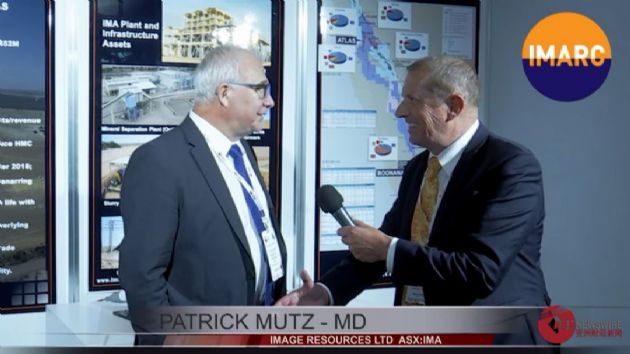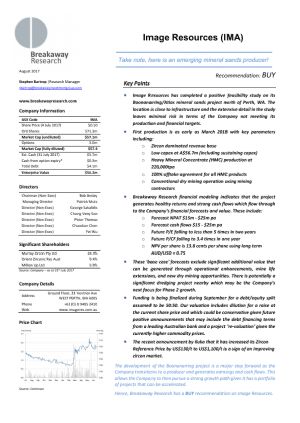Perth, Feb 11, 2009 AEST (ABN Newswire) - Results from the remaining 80% of the samples taken from first-pass aircore drilling at Image Resources' 100%-owned Serpentine Lakes during the September 2008 quarter have now been received. The 466sq km Serpentine Lakes project is situated along strike from the zircon-rich 1.8Mt Cyclone prospect. The Image drilling was aimed at strike extensions of the Cyclone mineralisation and testing of other targets on the Barton paleo-shoreline.
HIGHLIGHTS
- A high value mineral assemblage containing up to 45% zircon with a combined zircon and leucoxene content ranging from 81% to 90% indicated from limited sampling
- Three mineralised zones identified ranging from 300m to 700m in width and from at least 1.6km to 2.5km in length, with potential to extend into an unexplored tenement to the south. Better grades include 10m at 5.3%HM from 12m, 24m at 3.0%HM from 4m and 10m at 5.0%HM from 20m
- A fourth mineralised zone identified 25km to the east with little exploration completed between these zones
- A very low slime content of 4% for the shallower mineralisation, indicating amenability to low cost mining with high recoveries
- The zircon market continues to improve with prices around US$900/t
Mineralisation is present in two geological zones; the main zone is interpreted to be a typical shoreline style with low slime (4% within the mineralisation), well sorted sands and HM grades up to 13%. The low slime content is important as it indicates potential for low cost mining with good recoveries. The second zone is slightly deeper and interpreted to be a near-shore environment within silt and fine sand with an average slime content of about 8% and with HM grades up to 4%.
Four areas of mineralisation have been identified by this wide spaced drilling; three extending south from Diatreme Resources' Cyclone discovery and a new zone approximately 25km to the east near the South Australian border. The three areas south of Cyclone are (from west to east) 700m, 300m and 600m wide and are interpreted to extend for at least 2.5km, 1.6km and 2.0km along strike respectively.
The tenement to the south has not been explored and potential remains for extensions or repetitions of the mineralisation in this area. The fourth (eastern) area comprises two zones some 200m wide and open along strike. Preliminary cross sections of the mineralisation are shown in the figure above.
Mineralogical assessment of five 2m samples (which cannot be considered representative at this stage) have indicated that zircon ranges from 14% to 45% of the HM assemblage. The other dominant mineral identified is leucoxene ranging between 39% and 71% of the HM assemblage. The lower value ilmenite content ranges from 5% to 13% of the assemblage. The leucoxene has proved to be difficult to identify in the field and as a result many of the mineralised zones selected for laboratory processing remain open, with potential to further increase the extent of the mineralisation. Several hundred additional samples from the drilling are being selected for processing and will be reported as they come to hand in the next few weeks.
These results are considered to be most encouraging as they indicate a high proportion of the higher value minerals zircon and leucoxene in the mineral assemblage and a low trash content. Significantly, the zircon market appears to be continuing to firm with prices of up to US$900/t being reported. The leucoxene in the five test samples is mostly the magnetic variety, commanding a price of US$150-200/t depending on titanium content and impurity levels. Leucoxene is more valuable than ilmenite which is currently priced at up to US$130/t. The combined zircon and leucoxene content of the five test samples ranges from 81% to 90% demonstrating the potential for the mineralisation to be at the higher end of the heavy mineral value spectrum.
Image is carrying out further mineralogical test work on composite samples, together with the additional sample processing mentioned above, in preparation for the next phase of drilling on this promising HM project in the emerging Eucla Basin province.
About Image Resources NL
 Image Resources NL (ASX:IMA) is a mineral sands focused mining company operating an open-cut mine and ore processing facility at its 100%-owned, high-grade, zircon-rich Boonanarring Project, located 80km north of Perth in the infrastructure rich North Perth Basin.
Image Resources NL (ASX:IMA) is a mineral sands focused mining company operating an open-cut mine and ore processing facility at its 100%-owned, high-grade, zircon-rich Boonanarring Project, located 80km north of Perth in the infrastructure rich North Perth Basin.
Boonanarring is arguably one of the highest grade, zircon-rich mineral sands projects in Australia. Construction and project commissioning were completed on-time and on-budget in 2018. Production commenced in December 2018 and HMC production ramped-up to exceed name-plate capacity in only the second month of operation.
![abnnewswire.com]()
Related Companies
Social Media
Share this Article
 Image Resources NL (ASX:IMA) is a mineral sands focused mining company operating an open-cut mine and ore processing facility at its 100%-owned, high-grade, zircon-rich Boonanarring Project, located 80km north of Perth in the infrastructure rich North Perth Basin.
Image Resources NL (ASX:IMA) is a mineral sands focused mining company operating an open-cut mine and ore processing facility at its 100%-owned, high-grade, zircon-rich Boonanarring Project, located 80km north of Perth in the infrastructure rich North Perth Basin.






